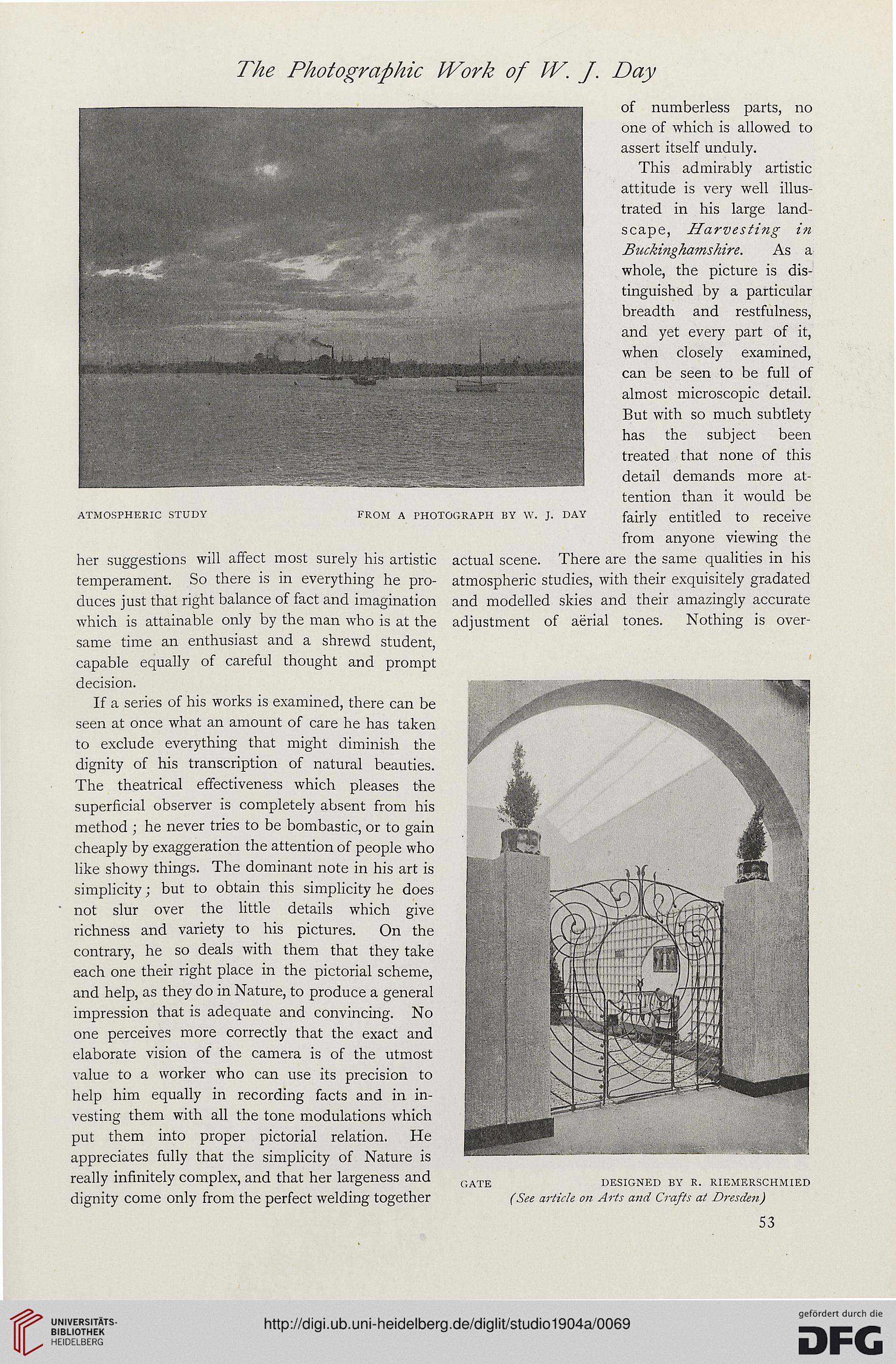The Photographic Work of IV. J. Day
of numberless parts, no
one of which is allowed to
assert itself unduly.
This admirably artistic
attitude is very well illus-
trated in his large land-
scape, Harvesting in
Buckinghamshire. As a
whole, the picture is dis-
tinguished by a particular
breadth and restfulness,
and yet every part of it,
when closely examined,
can be seen to be full of
almost microscopic detail.
But with so much subtlety-
has the subject been
treated that none of this
detail demands more at-
tention than it would be
atmospheric study from a photograph by w. j. day fairly entitled to receive
from anyone viewing the
her suggestions will affect most surely his artistic actual scene. There are the same qualities in his
temperament. So there is in everything he pro- atmospheric studies, with their exquisitely gradated
duces just that right balance of fact and imagination and modelled skies and their amazingly accurate
which is attainable only by the man who is at the adjustment of aerial tones. Nothing is over-
same time an enthusiast and a shrewd student,
capable equally of careful thought and prompt
If a series of his works is examined, there can be
seen at once what an amount of care he has taken
method; he never tries to be bombastic, or to gain ^^fe
cheaply by exaggeration the attention of people who \ I*
like showy things. The dominant note in his art is __lJf ( '
simplicity; but to obtain this simplicity he does ^^^xvv ^M^V
not slur over the little details which give
richness and variety to his pictures. On the
contrary, he so deals with them that they take
each one their right place in the pictorial scheme,
and help, as they do in Nature, to produce a general
impression that is adequate and convincing. No
one perceives more correctly that the exact and
elaborate vision of the camera is of the utmost
value to a worker who can use its precision to
help him equally in recording facts and in in-
vesting them with all the tone modulations which
put them into proper pictorial relation. He
appreciates fully that the simplicity of Nature is ^^^^^^^BaBmmmmm
really infinitely complex, and that her largeness and gate designed by r. riemerschmied
dignity come only from the perfect welding together (See article on Arts and Crafts at Dresden)
53
of numberless parts, no
one of which is allowed to
assert itself unduly.
This admirably artistic
attitude is very well illus-
trated in his large land-
scape, Harvesting in
Buckinghamshire. As a
whole, the picture is dis-
tinguished by a particular
breadth and restfulness,
and yet every part of it,
when closely examined,
can be seen to be full of
almost microscopic detail.
But with so much subtlety-
has the subject been
treated that none of this
detail demands more at-
tention than it would be
atmospheric study from a photograph by w. j. day fairly entitled to receive
from anyone viewing the
her suggestions will affect most surely his artistic actual scene. There are the same qualities in his
temperament. So there is in everything he pro- atmospheric studies, with their exquisitely gradated
duces just that right balance of fact and imagination and modelled skies and their amazingly accurate
which is attainable only by the man who is at the adjustment of aerial tones. Nothing is over-
same time an enthusiast and a shrewd student,
capable equally of careful thought and prompt
If a series of his works is examined, there can be
seen at once what an amount of care he has taken
method; he never tries to be bombastic, or to gain ^^fe
cheaply by exaggeration the attention of people who \ I*
like showy things. The dominant note in his art is __lJf ( '
simplicity; but to obtain this simplicity he does ^^^xvv ^M^V
not slur over the little details which give
richness and variety to his pictures. On the
contrary, he so deals with them that they take
each one their right place in the pictorial scheme,
and help, as they do in Nature, to produce a general
impression that is adequate and convincing. No
one perceives more correctly that the exact and
elaborate vision of the camera is of the utmost
value to a worker who can use its precision to
help him equally in recording facts and in in-
vesting them with all the tone modulations which
put them into proper pictorial relation. He
appreciates fully that the simplicity of Nature is ^^^^^^^BaBmmmmm
really infinitely complex, and that her largeness and gate designed by r. riemerschmied
dignity come only from the perfect welding together (See article on Arts and Crafts at Dresden)
53




